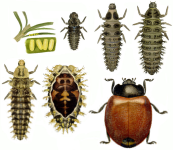 |
Scientific namePriscibrumus uropygialis (Mulsant) (=Exochomus uropygialis, Brumus uropygialis)
Taxonomic positionColeoptera: Coccinellidae: Chilocorinae: Chilocorini
DiagnosisLength 3.80-4.30 mm, width 2.82-3.00 mm. Very similar to E. lituratus in general appearance and coloration. Head, pronotum, and scutellum black. Elytra yellowish testaceous to reddish brown, with a small, black apical patch. Ventral side black, except elytral epipleura yellowish brown. Male genitalia (Figs) and life stages as illustrated.
ImagesDistributionIndia: Himachal Pradesh, Jammu & Kashmir, Sikkim, Uttar Pradesh, West Bengal; Pakistan;
Nepal; Bhutan. Widely distributed in coniferous forests between 1800 and 2750 min northwestern India and Pakistan.
Prey / Associated habitatHEMIPTERA: Aphidoidea: Adelges spp., Aphis gossypii Glover, Aphis sp. (cf. Gossypii Glover), Brachycaudus helichrysi (Kaltenbach), Brachycaudus
sp., Ceruraphis sp., Cinara sp., Dreyfusia (as Adelges) knucheli
(Schneider-Orelli & Schneider), Eriosoma lanigerum (Hausmann), Mindarus japonicus Takahashi, Myzus ornatus Laing, Myzus persicae (Sulzer), Myzus sp., Pemphigus
sp., Pineus sp. Diaspididae: Diaspidiotus perniciosus (Comstock), Salicicola sp. Psyllidae: indeterminate psyllids. Commonly associated with adelgids infesting silver fir and other coniferous trees in the northwestern region. Collected on potato.
Seasonal occurrenceActive during March-June. Collected during July-August and November.
Natural enemyDinocampus coccinellae (Schrank).
RemarksPriscibrumus lituratus and P. uropygialis belong to a complex of very similar species. Based on cytological studies on populations from India and Pakistan, Smith (1965) supposed that in the group lituratus, certainly, and in the group uropygialis, probably, five cytogenetically different (?sibling) species occurred together, some of them differing only in subtle physiological properties expressed in somewhat different ecological suitabilities.
References
|

